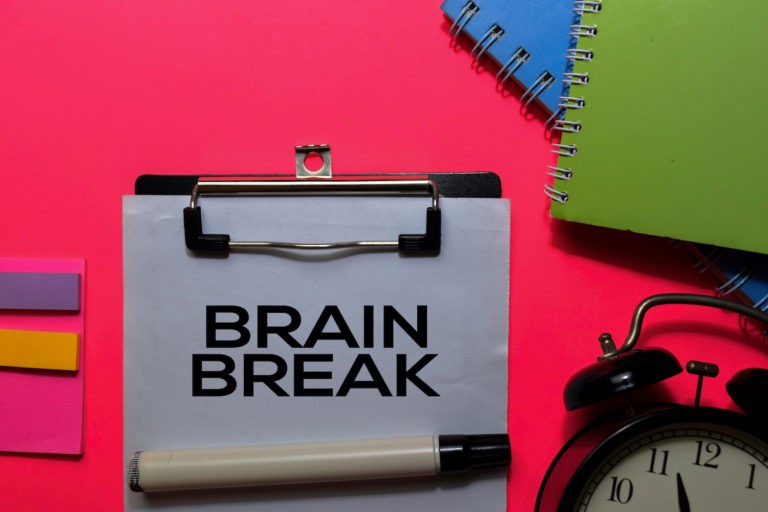Including brain research focused on enhancing brain function and brain-stimulating activities in lessons are imperative for effective learning in today’s classrooms. Students’ brains need to be stimulated to grow and learn. Including multiple types of brain breaks in your classrooms is necessary for maximum learning. There is a multitude of resources for teachers to incorporate appropriate brain breaks in the classroom, from online resources to simple games. Brain breaks in teaching boosts cognitive functioning and fosters the joy of learning.
What are Brain Breaks?
Brain breaks are an important part of learning. They are small mental breaks designed to help students focus and attend. They typically get students moving and allow blood and oxygen to flow to the brain. These breaks allow students a small reset in the day and enhance energy and relaxation. Research states that doubling students’ chronological age is comparable to their attention span. Too much, too fast, won’t last. Teachers’ goals are for students to retain information, and it is best to allow them time to think and process. Brain breaks are good for students at any age from Pre-K through college.
Brain breaks positively impact our emotional states. The hippocampus can only process so much information at once, and brain breaks allow students and teachers to reset for a few minutes. These breaks allow and develop creativity and social skills. A great example of this is allowing students to participate in a small dance break to music. This is such an effective way to allow students to break outside of their box and show their creativity. Sometimes the shy students in class may be afraid to speak up while answering questions, but will dance their heart out to music. It’s so fun and brings laughter to the classroom! Brain breaks should be considered an investment into the students’ and teachers’ day.
Benefits of Brain Breaks for Kids
Countless research supports incorporating brain breaks into teaching. The benefits include better behavior, increased productivity, enhanced comprehension, creative thinking, and increased time on task. They help students pay attention and are as important as the skills being taught. Teachers should structure their classes to where students are not focusing on one task too long and possibly becoming counterproductive. Brain breaks including music and movement positively stimulate their brains.
Brain breaks increase efficiency and performance in the classroom. They are valuable for students and teachers. Movement, music, and humor are all great ideas to incorporate into brain breaks. They reduce stress and frustration, and increase attention and productivity. Physical activity has so many benefits, and incorporating small bursts of these kinds of activities during lessons possess real advantages.
Brain Break Ideas and Activities to Try
Let the students know they are building up their brain power during these breaks, and plan brain breaks according to the age of the children you are working with. Schedule them into lessons, and set a timer to ensure they are implemented. Students need to engage in these breaks before they become distracted or tired. It is best to include a variety so all students can enjoy and look forward to them. Periodically allow students to decide what the brain break will be. An example would be to allow a student that has a birthday to choose the brain breaks for the day.
Teachers can also reinforce skills that are taught in class. This allows them to utilize different parts of their brains during the lesson. It is best to model the brain break and sometimes participate with students. The kids love to see the teacher in a different role. It is best to be flexible, and include opportunities to socialize and move. Incorporate games into learning, and brain breaks will be blended into the lesson.
Go Noodle is one of the most popular brain break websites, and students love it! There is a plethora of songs including reinforcing academic skills, stretches, and movement. These are free, short videos that help students engage in movement in the classroom.
Flocabulary is an online resource library full of songs and raps for classrooms K-12. The videos and activities present a myriad of skills in a rap song, and students can dance along. The songs are enjoyable and amusing. The Learning Station is another online resource that includes brain break videos for kids. The videos incorporate movement and dancing and are designed for young children.
Brain breaks can also include focusing attention practices to quiet the mind and many distractions in our day. They allow students to practice time outs and engage in think-time to process. Our thinking improves during this time and allows our emotions to regulate. This is when stretching poses such as those found in yoga are a perfect brain break. Examples of quieting the mind are turning the lights down and allowing students to sit or relocate to a quiet place in the room for just a few minutes. Another example would be to allow students to draw or work on a puzzle quietly for just a few minutes.
Brain breaks in teaching boost cognitive functioning and foster the joy of learning. Brain breaks should always be structured and planned according to what is going on in class. They are imperative in today’s classrooms, and allow teachers and students the opportunity for movement, quiet, and overall enjoyment.




